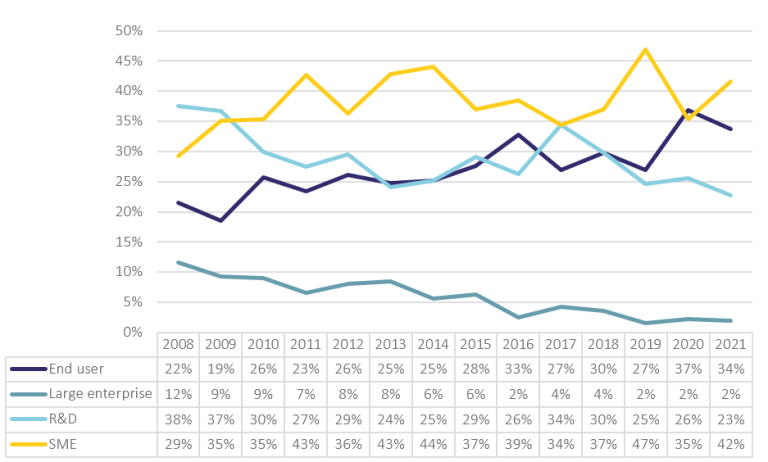Evolution of the programme and business aspects
Insights from the AAL Legacy study
Over the course of 14 annual calls between 2008 and 2021, the Active & Assisted Living (AAL) Programme channelled close to €1 billion in combined EU and national funding into more than 300 transnational innovation projects. These initiatives collectively engaged around 2,000 SMEs, 700 research and clinical institutes, and over 100 user-representative organisations, creating one of the largest cross-border ecosystems focused on technologies for ageing in place. This scale of activity laid a unique foundation for advancing market-driven solutions in active and healthy ageing.
How the programme adapted and expanded
When the Active & Assisted Living (AAL) Programme launched its first call in 2008, it followed the model of a traditional research initiative: a small central management unit oversaw nationally funded projects, calls were organised around narrowly defined technology topics, and success was primarily measured by the delivery of prototypes. While this “technology-push” approach attracted strong research teams, it also revealed several structural weaknesses early on—contracting delays caused by differing national procedures, solutions that covered only isolated aspects of older adults’ daily lives, and limited opportunities for commercial continuation after the end of public funding.
A mid-term evaluation in 2013 triggered a profound redesign. The second phase of the programme (2014–2021) replaced narrowly defined calls with broader, challenge-based topics—such as “Living well with dementia” and “Smart solutions for ageing in place.” These new calls encouraged the formation of multidisciplinary consortia able to address clinical, social, and economic aspects within a single project. The shift aimed to promote more integrated development approaches that better reflected the complexity of real-life contexts.
In parallel, the programme refined its internal governance and evaluation tools to better support market-oriented innovation. Evaluation grids were rewritten to give substantial weight to business plans, regulatory roadmaps, and documented end-user co-creation. At the same time, the Central Management Unit gained stronger steering powers: a harmonised Manual of Procedures, a Salesforce-based project desk, and binding service-level agreements with national agencies helped reduce the median time-to-contract from over twelve months in the early calls to under six months in later ones. Budget under-utilisation in slower jurisdictions also declined significantly as a result.
The structure of project consortia reflected this new orientation. In the final years of the programme, over 85% of funded projects brought together business partners, research institutions, and end-user organisations—frequently with a public payer as an additional partner. Small and medium-sized enterprises (SMEs) became central actors. Their participation rose above 40%, and they took on project coordination roles in nearly two-thirds of later-stage calls. This change was directly encouraged by evaluation criteria that rewarded strong business models and market-readiness.

AAL also diversified its funding instruments to better serve early-stage business needs. Alongside the standard 30-month projects, Small Collaborative Projects lasting 6 to 9 months allowed for “fail-fast” experimentation, making it easier for entrepreneurs to test concepts with minimal risk. A flexible reconfiguration window enabled consortia to bring in new partners—especially from underrepresented countries—without restarting the entire process.
Support measures and lasting impact
Support measures played a crucial enabling role. Programmes like AAL2Business provided acceleration tools tailored to the needs of SMEs and start-ups. Services included investor and business coaching, matchmaking events, and regulatory clinics that helped entrepreneurs navigate Europe’s fragmented healthtech environment. One key offering, the Lean-Start-up Academy, proved especially effective: 72% of participating projects went on to secure follow-on financing—more than twice the average success rate in the wider field.
Business support was not peripheral; it became increasingly embedded into project lifecycles. Mid-term reviews encouraged projects to engage with coaches and investors. Dedicated advisory services provided insights into intellectual property management, certification pathways, and market-entry strategies. When recurring issues emerged—such as difficulties navigating medical-device regulation—the programme reacted swiftly by integrating specialised certification clinics into its support offer.
The AAL Programme also demonstrated agility in response to external shocks. Despite the COVID-19 pandemic, it successfully launched and evaluated its 2020 call entirely online. Hybrid matchmaking and investor events not only continued without interruption but reached four times more stakeholders than traditional formats, and at significantly lower cost.
As AAL wound down, it took steps to preserve its business support infrastructure. Tools and materials developed through the programme—such as investor readiness guides, ethics templates, and market observatories—were transferred to successor partnerships under Horizon Europe. And the local innovation ecosystems it helped nurture in regions like Central Denmark and Coimbra remain active testbeds for new EU-funded healthtech initiatives.